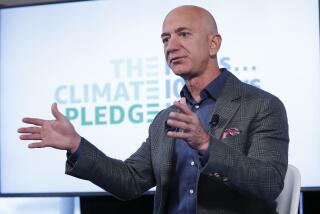Avoiding Costly Consumers
- Share via
MINNEAPOLIS — So much for the customer always being right.
Some retailers are deciding that the customer can be very, very wrong -- as in unprofitable. And some, including Best Buy Co., are discriminating between profitable customers and shoppers they lose money on.
There is the customer who ties up a salesperson but never buys anything, or who buys only during big sales. And then there is the one who files for a rebate, then returns the item.
“That would be directly equivalent to somebody going to an ATM and getting money out without putting any in,” said Best Buy Chief Executive Brad Anderson. “Those customers, they’re smart, and they’re costing us money.”
Anderson said Best Buy was tightening its rebate policies in the case of customers who abused the privilege, but declined to say what else his company was doing to discourage its most costly customers.
“What we’re trying to do is not eliminate those customers, but just diminish the number of offers we make to them,” Anderson said.
Larry Selden calls them “demon customers.”
Selden, a consultant who works for Best Buy, co-wrote “Angel Customers & Demon Customers.” In his book, he said that although retailers “probably can’t hire a bouncer to stand at the door and identify the value destroyer,” they’re not powerless.
Selden, a business professor emeritus at Columbia University, said an investment firm found that one customer with a portfolio of $500,000 was tying up three financial advisors almost full-time with requests for help and information. “Eventually, reluctantly, and very politely, in this one case the company asked him to go elsewhere,” he said.
Selden worked as a consultant for Royal Bank of Canada, which at one time traced checks faster for its most profitable customers, while other customers waited up to five days, he wrote. Although that’s a bit out of date, the bank now has other ways of prioritizing customers.
Laura Gainey, vice president of client segment strategies, said the bank’s phone system sent certain customers to the front of the line, where they got the most experienced customer service representatives, depending on criteria that included their account size.
“There are different ways of approaching different customers, which will allow us to better serve their needs, and allow us to serve the bank and our shareholders’ needs,” she said.
Sometimes it’s the retailer’s fault that a customer is unprofitable, Selden said.
“Then there are those customers that are just evil customers ... fundamentally they’re out to cheat us,” he said. “It’s not a large number of customers, but they can have a material impact on a business.”
Once in a while, stores need to “fire” their worst customers, Selden said. Filene’s banned two sisters from all 21 of its stores last year after the clothing chain’s corporate parent, May Department Stores Co., decided they had returned too many items and complained too often about service.
The sisters said they had been loyal customers for years.
Best Buy Executive Vice President Philip Schoonover said the company disagreed with the idea of “firing” some customers. The company will try to find ways to make money-losing customers profitable, he said.
Retail consultant Karl Bjornson of Kurt Salmon Associates said discouraging bad customers could work if a company was careful about it. He said it generally worked better, say, to offer fewer sales rather than to discourage individual customers who shopped aggressively on price.
Every store has customers it doesn’t like, he said. “The question is, how public do you go with it, and how big a deal do you make out of it?”
More to Read
Inside the business of entertainment
The Wide Shot brings you news, analysis and insights on everything from streaming wars to production — and what it all means for the future.
You may occasionally receive promotional content from the Los Angeles Times.










